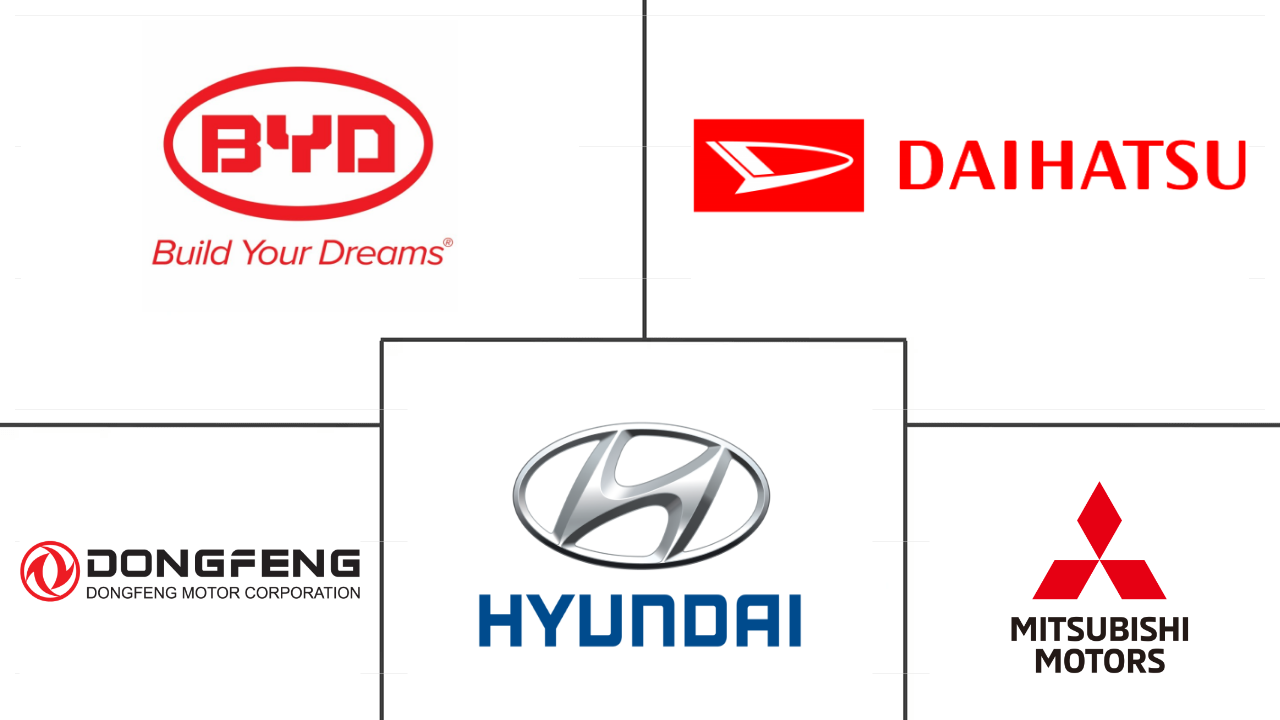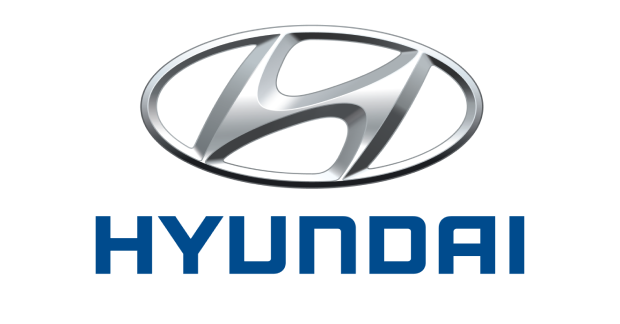Market Size of asia pacific electric commercial vehicles Industry
| Icons | Lable | Value |
|---|---|---|
|
|
Study Period | 2017 - 2030 |
|
|
Market Size (2024) | USD 87.81 Billion |
|
|
Market Size (2030) | USD 268.7 Billion |
|
|
Largest Share by Fuel Category | BEV |
|
|
CAGR (2024 - 2030) | 20.49 % |
|
|
Largest Share by Country | China |
|
|
Market Concentration | Medium |
Major Players |
||

|
||
|
*Disclaimer: Major Players sorted in no particular order |
Asia Pacific Electric Commercial Vehicles Market Analysis
The Asia Pacific Electric Commercial Vehicles Market size is estimated at 87.81 billion USD in 2024, and is expected to reach 268.7 billion USD by 2030, growing at a CAGR of 20.49% during the forecast period (2024-2030).
87.81 Billion
Market Size in 2024 (USD)
268.7 Billion
Market Size in 2030 (USD)
19.01 %
CAGR (2017-2023)
20.49 %
CAGR (2024-2030)
Largest Segment by Vehicle Body Type
47.37 %
value share, Buses, 2023
Light Commercial Trucks lead due to their versatility, high demand in urban and rural areas, and suitability for various commercial applications, making them a popular choice in the region.
Fastest-growing Segment by Vehicle Body Type
38.04 %
Projected CAGR, Medium-duty Commercial Trucks, 2024-2030
Heavy-duty Commercial Trucks are the fastest-growing due to increasing investments in electric vehicle technology, the need for sustainable logistics solutions, and supportive government policies.
Largest Segment by Fuel Category
89.45 %
value share, BEV, 2023
BEVs dominate the fuel category due to advancements in battery technology, government incentives, and increasing infrastructure supporting electric vehicles in the Asia-Pacific region.
Fastest-growing Segment by Fuel Category
40.24 %
Projected CAGR, FCEV, 2024-2030
FCEVs are growing rapidly due to advancements in hydrogen fuel cell technology, expanding hydrogen refueling infrastructure, and a push for zero-emission commercial vehicles.
Leading Market Player
48.21 %
market share, Hyundai Motor Company, 2023

Hyundai Motor Company dominates the market due to its advanced electric vehicle technology, extensive product range, and strong commitment to sustainability and innovation in the Asia-Pacific region.
The adoption of hybrid and electric commercial vehicles in Asia-Pacific is expected to be more than triple by 2030
- Asia-Pacific's transition toward greener transportation solutions has been pronouncedly evident in the hybrid and electric commercial vehicle (CV) sector between 2022 and 2023. The collective figures for hybrid and electric CV registrations rose significantly, reaching 490,958 units in 2022 from the previous 264,007 units in 2021. These numbers signify not only a rebound from the prior slump but also underline a strong preference for these cleaner technologies amid escalating environmental concerns and progressive governmental policies.
- Historical data provides an intriguing context. From 2017 to 2019, the combined registrations for hybrid and electric CVs experienced a gentle downward trend, from 260,519 units to 188,118 units. This dip might be attributed to factors like infrastructure readiness, vehicle price points, and initial hesitations. However, the next few years, especially 2022, saw a dramatic resurrection in the numbers, emphasizing the region's fast-adapting stance to combat emissions through cleaner CV solutions.
- Projecting into the future, the upward trajectory for hybrid and electric CVs in Asia-Pacific is remarkably optimistic. By 2025, it is estimated the numbers will cross the 926,761 units mark. By 2030, the total registrations are anticipated to reach an impressive 1,677,598 units. This forecasted upswing can be attributed to technological breakthroughs, a matured charging infrastructure, reduced total cost of ownership, and the realization of the critical role these vehicles play in achieving sustainability goals.
The Asia-Pacific electric commercial vehicles market is poised for rapid expansion, fueled by stringent emission regulations and a robust push for greener public and logistic transport solutions
- Asia-Pacific represents one of the most dynamic markets for electric commercial vehicles due to its diverse economies, rapidly growing urbanization, and increasing focus on reducing carbon emissions. The market landscape varies significantly by country, reflecting differences in economic development, government policies, infrastructure readiness, and industry adoption rates. China, as a global leader in electric vehicle technology, dominates the ECV market in Asia Pacific, benefiting from aggressive government policies, substantial investments in charging infrastructure, and a wide range of domestic manufacturers.
- Other countries in the region, such as Japan and South Korea, are also making significant strides in the electric commercial vehicle market. Japan, with its well-established automotive industry, is focusing on hydrogen fuel cell vehicles as part of its broader strategy for ECVs alongside BEVs. The country's commitment to creating a 'hydrogen society' complements its efforts in electrifying its commercial vehicle segment. South Korea, on the other hand, is rapidly advancing in battery technology and infrastructure development.
- In contrast, emerging economies in the region, such as India, Indonesia, and Thailand, are in the earlier stages of ECV adoption, facing challenges such as limited infrastructure and higher upfront costs. However, these countries hold significant potential for growth in the ECV market due to increasing urbanization, rising awareness of environmental issues, and government initiatives aimed at encouraging the use of electric vehicles. India, for example, has launched multiple initiatives to boost EV adoption, focusing on both improving infrastructure and offering subsidies to buyers.
Asia Pacific Electric Commercial Vehicles Industry Segmentation
Buses, Heavy-duty Commercial Trucks, Light Commercial Pick-up Trucks, Light Commercial Vans, Medium-duty Commercial Trucks are covered as segments by Vehicle Body Type. BEV, FCEV, HEV, PHEV are covered as segments by Fuel Category. Australia, China, India, Indonesia, Japan, Malaysia, South Korea, Thailand, Rest-of-APAC are covered as segments by Country.
- Asia-Pacific's transition toward greener transportation solutions has been pronouncedly evident in the hybrid and electric commercial vehicle (CV) sector between 2022 and 2023. The collective figures for hybrid and electric CV registrations rose significantly, reaching 490,958 units in 2022 from the previous 264,007 units in 2021. These numbers signify not only a rebound from the prior slump but also underline a strong preference for these cleaner technologies amid escalating environmental concerns and progressive governmental policies.
- Historical data provides an intriguing context. From 2017 to 2019, the combined registrations for hybrid and electric CVs experienced a gentle downward trend, from 260,519 units to 188,118 units. This dip might be attributed to factors like infrastructure readiness, vehicle price points, and initial hesitations. However, the next few years, especially 2022, saw a dramatic resurrection in the numbers, emphasizing the region's fast-adapting stance to combat emissions through cleaner CV solutions.
- Projecting into the future, the upward trajectory for hybrid and electric CVs in Asia-Pacific is remarkably optimistic. By 2025, it is estimated the numbers will cross the 926,761 units mark. By 2030, the total registrations are anticipated to reach an impressive 1,677,598 units. This forecasted upswing can be attributed to technological breakthroughs, a matured charging infrastructure, reduced total cost of ownership, and the realization of the critical role these vehicles play in achieving sustainability goals.
| Vehicle Body Type | |
| Buses | |
| Heavy-duty Commercial Trucks | |
| Light Commercial Pick-up Trucks | |
| Light Commercial Vans | |
| Medium-duty Commercial Trucks |
| Fuel Category | |
| BEV | |
| FCEV | |
| HEV | |
| PHEV |
| Country | |
| Australia | |
| China | |
| India | |
| Indonesia | |
| Japan | |
| Malaysia | |
| South Korea | |
| Thailand | |
| Rest-of-APAC |
Asia Pacific Electric Commercial Vehicles Market Size Summary
The Asia Pacific Electric Commercial Vehicles Market is experiencing a significant transformation, driven by the region's commitment to greener transportation solutions. The market is characterized by a robust shift towards hybrid and electric commercial vehicles, reflecting a strong preference for cleaner technologies amid growing environmental concerns and supportive governmental policies. The market landscape is diverse, with countries like China leading the charge due to its advanced electric vehicle technology and substantial investments in charging infrastructure. Meanwhile, Japan and South Korea are making notable advancements, focusing on hydrogen fuel cell vehicles and battery technology, respectively. Emerging economies such as India, Indonesia, and Thailand, despite facing challenges like limited infrastructure, are poised for growth due to increasing urbanization and government initiatives promoting electric vehicle adoption.
The market's growth trajectory is underpinned by technological advancements, a matured charging infrastructure, and the decreasing total cost of ownership of electric commercial vehicles. Governments across the region are actively proposing measures to phase out fossil fuel vehicles, further bolstering the market. Initiatives like the expansion of electric bus fleets and significant contracts for electric vehicle supply are indicative of the region's commitment to reducing carbon emissions. The market is moderately consolidated, with major players such as BYD Auto Co. Ltd., Daihatsu Motor Co. Ltd., Dongfeng Motor Corporation, Hyundai Motor Company, and Mitsubishi Motors Corporation playing pivotal roles. These developments are expected to drive the demand for electric commercial vehicles in the Asia Pacific region significantly over the forecast period.
Asia Pacific Electric Commercial Vehicles Market Size - Table of Contents
-
1. MARKET SEGMENTATION (includes market size in Value in USD and Volume, Forecasts up to 2030 and analysis of growth prospects)
-
1.1 Vehicle Body Type
-
1.1.1 Buses
-
1.1.2 Heavy-duty Commercial Trucks
-
1.1.3 Light Commercial Pick-up Trucks
-
1.1.4 Light Commercial Vans
-
1.1.5 Medium-duty Commercial Trucks
-
-
1.2 Fuel Category
-
1.2.1 BEV
-
1.2.2 FCEV
-
1.2.3 HEV
-
1.2.4 PHEV
-
-
1.3 Country
-
1.3.1 Australia
-
1.3.2 China
-
1.3.3 India
-
1.3.4 Indonesia
-
1.3.5 Japan
-
1.3.6 Malaysia
-
1.3.7 South Korea
-
1.3.8 Thailand
-
1.3.9 Rest-of-APAC
-
-
Asia Pacific Electric Commercial Vehicles Market Size FAQs
How big is the Asia Pacific Electric Commercial Vehicles Market?
The Asia Pacific Electric Commercial Vehicles Market size is expected to reach USD 87.81 billion in 2024 and grow at a CAGR of 20.49% to reach USD 268.66 billion by 2030.
What is the current Asia Pacific Electric Commercial Vehicles Market size?
In 2024, the Asia Pacific Electric Commercial Vehicles Market size is expected to reach USD 87.81 billion.

